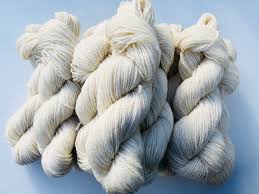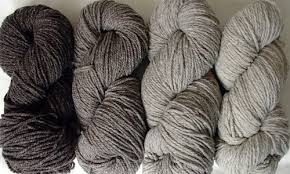In the textile industry, understanding yarn specifications is crucial for selecting the appropriate material for various applications. One such specification is the yarn count, which indicates the thickness or fineness of the yarn. This article delves into the characteristics of 40-count sheep wool yarn, comparing it with other yarn types to provide a comprehensive understanding of its advantages and potential uses.
Understanding Yarn Count
Yarn count is a numerical expression that defines the fineness or coarseness of a yarn. It is determined by the length of yarn per unit weight. There are two primary systems for measuring yarn count:
-
Indirect System: Commonly used for cotton, wool, and spun silk, where a higher count signifies a finer yarn. For instance, in the cotton count system, a 40s yarn is finer than a 20s yarn.
-
Direct System: Utilized for synthetic fibers, where the count represents the weight of a fixed length of yarn. Here, a higher count indicates a thicker yarn.
In the context of wool, the worsted count system is often employed, where the count refers to the number of 560-yard hanks per pound of yarn. Thus, a 40-count worsted wool yarn means that one pound of this yarn comprises 40 hanks, each measuring 560 yards, totaling 22,400 yards per pound.

Characteristics of 40-Count Sheep Wool Yarn
A 40-count sheep wool yarn is considered a fine yarn, offering several notable characteristics:
-
Softness and Comfort: The fineness of the yarn contributes to a softer texture, making it suitable for garments worn close to the skin.
-
Lightweight: Fabrics made from this yarn are lightweight and breathable, ideal for layering and transitional clothing.
-
Durability: Despite its fineness, wool fibers possess inherent elasticity and resilience, providing durability to the fabric.
-
Thermal Regulation: Wool naturally offers excellent insulation, keeping the wearer warm in cold conditions and cool in warmer environments.
Comparing 40-Count Wool Yarn with Other Yarn Types
To appreciate the distinct qualities of 40-count wool yarn, it's beneficial to compare it with other common yarn types, including cotton, acrylic, and other wool variations.
Wool vs. Cotton Yarns
Cotton Yarn:
-
Fiber Origin: Derived from the cotton plant, making it a natural cellulose fiber.
-
Texture and Feel: Generally smooth with a crisp hand, offering excellent stitch definition.
-
Elasticity: Lacks inherent elasticity, which can lead to stretching over time.
-
Moisture Absorption: Highly absorbent but tends to retain moisture, leading to longer drying times.
-
Thermal Properties: Breathable and cool, suitable for warm climates and summer garments.
Comparison with 40-Count Wool:
-
Softness: Wool is typically softer and more insulating than cotton, providing better comfort in cooler conditions.
-
Elasticity: Wool's natural elasticity helps garments maintain their shape better than cotton.
-
Moisture Management: Wool can wick moisture away from the body and dries faster than cotton, enhancing comfort during wear.
-
Seasonal Suitability: While cotton is preferred for summer wear due to its breathability, fine wool like 40-count can be versatile across seasons due to its thermal regulating properties.
Wool vs. Acrylic Yarns
Acrylic Yarn:
-
Fiber Origin: Synthetic, made from polymer fibers.
-
Texture and Feel: Can mimic the softness of wool but often lacks the same luxurious feel.
-
Durability: Resistant to moths and mildew; however, it may pill over time.
-
Elasticity: Generally less elastic than wool, which can affect the drape and fit of garments.
-
Moisture Management: Less breathable and can retain odors more than natural fibers.
Comparison with 40-Count Wool:
-
Natural vs. Synthetic: Wool is a natural fiber with inherent benefits like biodegradability and sustainability, whereas acrylic is synthetic and less eco-friendly.
-
Comfort: Wool offers superior breathability and moisture-wicking capabilities, enhancing wearer comfort.
-
Durability: Wool's natural resilience often results in longer-lasting garments compared to acrylic, which may degrade faster with wear and washing.
-
Care Requirements: Acrylic is generally easier to care for, being machine washable and less prone to shrinking, whereas wool requires more delicate handling.
Wool Variations: 40-Count vs. Other Wool Yarns
Coarser Wool Yarns (e.g., 10-20 Count):
-
Texture: Thicker and may feel rougher against the skin.
-
Use Cases: Suitable for outerwear, rugs, and heavy blankets where durability is prioritized over softness.
Finer Wool Yarns (e.g., 60-80 Count):
-
Texture: Extremely fine and soft, often used in high-end suiting and luxury garments.
-
Durability: While soft, these finer yarns can be more delicate and may require more careful handling.
Comparison:
-
Versatility: 40-count wool strikes a balance between softness and durability, making it versatile for various applications, including lightweight sweaters, scarves, and baby garments.
-
Affordability: Typically more affordable than ultra-fine wool yarns, offering a good compromise between quality and cost.
Applications of 40-Count Sheep Wool Yarn

Given its balanced properties, 40-count sheep wool yarn is suitable for a range of textile applications:
-
Apparel: Ideal for crafting lightweight sweaters, cardigans, and dresses that require a soft hand and good drape.
-
Accessories: Perfect for scarves, shawls, and hats where comfort against the skin is essential.
-
Baby Clothing: The softness and warmth make it suitable for delicate baby garments and blankets.
-
Fine Knitting and Weaving: Appropriate for projects that require detailed stitch work and a smooth finish.
Conclusion
Understanding the nuances of yarn count and fiber characteristics is essential for selecting the right material for any textile project. A 40-count sheep wool yarn offers a harmonious blend of softness, durability, and versatility, distinguishing it from other yarn types like cotton and acrylic. Its unique properties make it a preferred choice for a variety of applications, particularly where comfort and quality are paramount. By considering the specific requirements of your project and the comparative attributes of different yarns, you can make informed decisions that enhance the outcome of your textile creations.
Exploring the Benefits of 40 Count Sheep Wool Yarn for Knitting and Crocheting
www.jinhangyarn.com
Jiangyin Jinhang Textile Co. Ltd.
